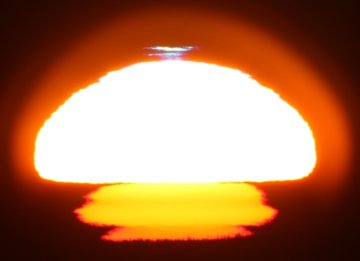| ISS TOOLBAG UPDATE: The toolbag dropped by spacewalking astronaut Heide Stefanyshyn-Piper in Nov. 2008 is still orbiting Earth. "Last night (Jan. 12th) we threw a Toolbag Sighting Party in Cabo Rojo, Puerto Rico," reports Eddie Irizarry of the Astronomical Society of the Caribbean. "Using just a pair of 7x50 binoculars, Joxelle Velazquez was the first to spot the tumbling object passing 1o below the Pleiades star cluster. It was about as bright as a 6th magnitude star. The Toolbag party was a success!" Readers, you too can see the toolbag; click here for flyby predictions. EXTRA MOONLIGHT: No, it wasn't your imagination. The full Moon of Jan. 11th really was extra bright. Dr. Elmar Schmidt of the SRH University of Applied Sciences in Heidelberg, Germany, used an absolutely-calibrated photometer to precisely measure the moonlight and found it more than 50% brighter than that of a typical full Moon. This made it possible, for example, to skate the frozen canals of the Netherlands long after dark: 
"The bright moonlight was perfect for skating," says Jan Koeman of Oosterschenge. "I photographed the skaters using my Nikon D300--no flash required." Three factors contributed to the Moon's extraordinary brightness: 1. The Moon was at perigee, the side of the Moon's elliptical orbit closest to Earth. 2. The Earth-Moon system was near perihelion, the side of Earth's elliptical orbit closest to the sun. Extra sunlight increased the reflected luminosity of the Moon. 3. The Sun-Earth-Moon trio were almost perfectly aligned. This triggered a strong opposition effect--an intense brightening of the lunar surface caused by the temporary elimination of normal shadows. Schmidt details the relative contributions of each factor in his full report. more images: from Shawn Malone of Marquette, Michigan; from John Clipperton of Chester, UK; from Danny Ratcliffe of Deception Bay, Queensland, Australia; from Klipsi of Sion in the Swiss Alps; from George Tarsoudis of Alexandroupolis, Greece; from Bob King of Duluth, Minnesota; from Bob Clark of Gold Coast, Queensland, Australia; BLUE FLASH: On Jan. 11, Wolfgang Ott of Stuttgart, Germany, decided to climb to the top of a television tower to watch the sunset. Why would he do that? From up there you can see sunsets like this: 
"It was breathtaking," says Ott. "I saw my first blue flash and managed to photograph it using my Canon EOS 450D." The blue flash is an elusive first cousin of the better-known green flash. Both are caused by air temperature gradients that distort the shape of the sun and magnify wisps of color on the sun's upper rim. Although these mirages happen frequently, the blue flashes they produce are seldom seen. Atmospheric optics expert Les Cowley explains why: "The reason is that rays of the setting sun travel through miles of our dense lower atmosphere and the air preferentially scatters away the blue light. Dust and aerosol dim it further. But when the air is exceptionally clean and we are above ground level we see the blue!" Fortunately, a TV tower is not required to experience the phenomenon. Cowley offers these observing tips.
Comet Lulin Photo Gallery
[sky map] [Comet Hunter Telescope] | 
